US10247479 — VORTEX WELL INERTING — L’Air Liquide, Societe Anonyme pour l’Etude et l’Exploitation des Procedes Georges Claude (France) — A method of providing an inerting atmosphere to the surface of molten aluminum in a vortex charge well of a reverberatory melting furnace is provided. The purpose is to improve aluminum recovery (reduce aluminum oxidation melt loss) by displacing the ambient atmosphere above the molten vortex with an inert gas. The method includes introducing a flow of an inerting gas into an inerting region immediately above the surface of the vortex charge well. The inerting gas may be selected from the group consisting of nitrogen, argon, or a mixture thereof. The inerting gas may be introduced into the charge inlet chute, through a diffuser, or a ring manifold. The vortex charge well may include a lid.
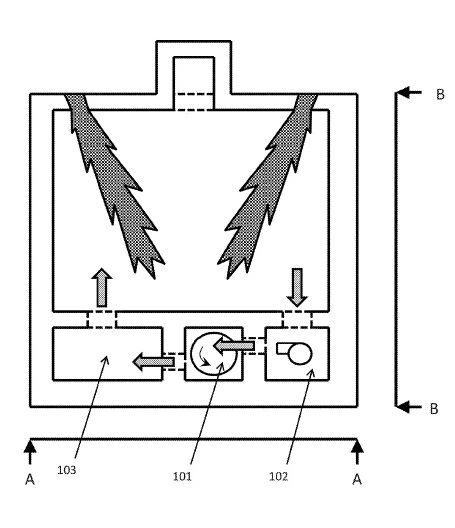
US10220418 — METHOD AND SYSTEM FOR RECYCLING ALUMINUM ALLOY RIMS USING SPECTROGRAPHIC ANALYSIS — House of Metals Company Limited (Canada) — A method and system of recycling aluminum alloy automotive rims, the method and system comprising providing a feed of a plurality of aluminum alloy rims of different alloys, for each rim in the feed of aluminum alloy rims, determining a composition of that aluminum alloy rim, determining a plurality of recycled aluminum alloy composition ranges, and dividing the feed of aluminum alloy rims into a plurality of batches of aluminum alloy rims, each batch of aluminum alloy rims in the plurality of batches of aluminum alloy rims corresponding to an associated recycled aluminum alloy composition range in the plurality of recycled aluminum composition ranges, such that each rim in the plurality of aluminum alloy rims is allocated to an associated batch in the plurality of batches of aluminum alloy rims based on the composition of that aluminum alloy rim.
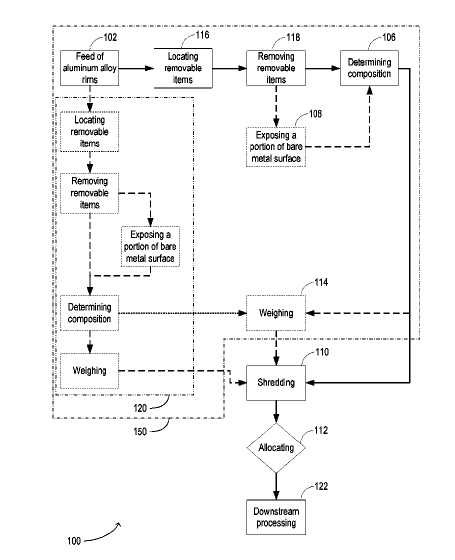
US10207296 — MATERIAL SORTING SYSTEM — UHV Technologies, Inc. (USA) — A material sorting system sorts materials, such as scrap pieces composed of unknown metal alloys, as a function of their detected x-ray fluorescence. The x-ray fluorescence may be converted into an elemental composition signature that is then compared to an elemental composition signature of a reference material in order to identify and/or classify each of the materials, which are then sorted into separate groups based on such an identification/classification. The material sorting system may include an in-line x-ray tube having a plurality of separate x-ray sources, each of which can irradiate a separate stream of materials to be sorted. Correspondingly, it is particularly desirable to efficiently separate aluminum scrap metals into alloy families, since mixed aluminum scrap of the same alloy family is worth much more than that of indiscriminately mixed alloys. For example, in the blending methods used to recycle aluminum, any quantity of scrap composed of similar, or the same, alloys and of consistent quality, has more value than scrap consisting of mixed aluminum alloys.

US10131967 — SCRAP SUBMERGENCE WALLED WELL — Pyrotek, Inc. (USA) — The present invention is directed to a scrap submergence system of the type typically employed in metal recycling processes, such as, the recycling of aluminum. In the recycling of metals, it is necessary to melt scrap pieces for treatment and processing. A large portion of aluminum scrap pieces are thin walled as a result of the mechanical shaping action from which they are formed, such as, shaving, boring and cold rolling. Melting thin walled scrap pieces is particularly difficult because rapid submerging in molten metal is severely hampered by the fact that thin walled scrap pieces float on molten metal. Problematically, extended exposure to the hostile atmosphere in a traditional melting furnace results in extremely high oxidation loss A scrap submergence device having an open top chamber including walls constructed of a heat resistant material is provided. The chamber includes an inlet in the side wall of the chamber for receiving molten metal, an outlet in the side wall of said chamber, and an interior wall extending from the base wall. The interior wall has a height lower than a height of the at least one side wall. The inlet is disposed on a first side of the interior wall and the outlet is disposed on a second side of the interior wall.

US10112737 — METHOD FOR THE MANUFACTURE OF AN ALUMINUM SHEET PRODUCT FROM USED BEVERAGE CONTAINERS — Golden Aluminum, Inc. (USA) — Current alloy chemistries in aluminum cans create a metallurgical limit on the relative percentage of aluminum feedstock that can be derived from UBC’s. Thus, while the magnesium level in a UBC melt is above the magnesium level in the AA 5182 alloy, it is above the magnesium level in the AA 3004 alloy. Magnesium is a much more effective hot or cold work hardener compared to manganese. Higher magnesium levels in body stock can increase tear offs in the body maker and lead to problems in fabricating the neck and flange. These and other needs are addressed by the various aspects, embodiments, and configurations of the present disclosure. The present disclosure is directed to an aluminum alloy composition that can be recycled and used for both body and end stock with relatively little compositional adjustments for body stock.

US10087507 — BEVERAGE CONTAINER — Golden Aluminum, Inc. (USA) — An aluminum alloy and recycle method are provided in which the recycled used beverage containers form an alloy composition useful with relatively minor or no compositional adjustments for body, end and tab stock, apart from magnesium levels.

US10017867 — ELECTROREFINING OF MAGNESIUM FROM SCRAP METAL ALUMINUM OR MAGNESIUM ALLOYS — Phinix, LLC (USA) — The present invention relates to a density-based three-liquid electrorefining process to continuously extract primary-quality Mg-Al or Al-Mg alloys from molten Al scrap acting as feedstock for secondary Al-alloy. The chemical composition of both the Al scrap feedstock as well as the Al-Mg alloy products may be variable depending on scrap supply, product demand and cost. The electrorefining can selectively transfer Mg from Al-Mg alloy bottom layer to Mg-Al alloy floating top layer. The invention comprises methods and apparatuses for the electrorefining of Mg from Al or Mg alloy scrap. The invention utilizes the density and charge features of Mg present in a melted alloy to continuously extract Mg and Mg alloys from a melted Al alloy feed.

US9702022 — PROCESS AND SYSTEM FOR DE-COATING OF ALUMINUM SCRAP CONTAMINATED WITH ORGANIC COATINGS — Industrial Furnace Company (USA) — A method for removal of organic coatings from loose aluminum scrap includes passing the scrap through a Multiple Hearth Furnace operatively maintained in the range of 500°F-1600°F. Each hearth in the furnace is independently temperature controlled and held under a slightly negative pressure environment. The hearths heat the scrap such that pyrolysis of the coatings occurs within the hearth. Organic compounds liberated during this process are partially or entirely consumed within the furnace combustion products are exhausted through the top. Hydrogen fluoride contained in the products of combustion is incinerated prior to final discharge from the system and routing to additional environmental equipment for particle removal. Scrap is continuously fed into the top of the furnace and agitated and mechanically moved within each hearth toward an output of another hearth therebelow. The agitation and movement of the scrap exposes the scrap to the hearth atmosphere to assist in processing of the scrap. The discharge of the scrap in the final hearth supplies hot (250°F-900°F), clean material for the next step in the process for secondary aluminum recycling.
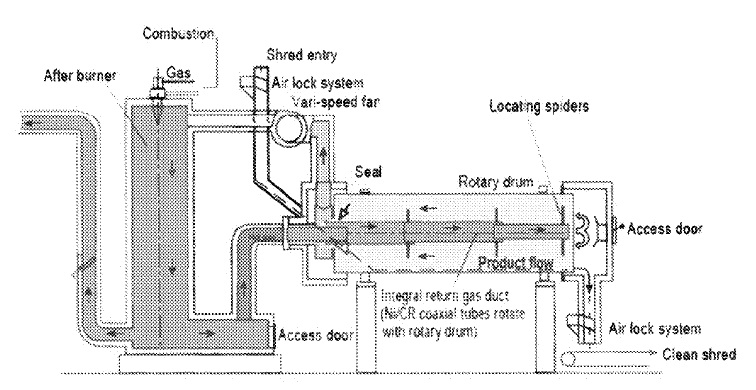
US9956609 — METAL SORTING, MELTING AND FABRICATION APPARATUS AND METHODS — Melt Cognition, LLC (USA) — Currently, casting metal products such as those made from aluminum using scrap is a multi-stage process with stages typically being performed at multiple facilities. Conventionally, at least three stages are performed at different industrial sites: i) the scrap is sorted at a scrap yard; ii) the scrap is transported to a secondary smelter where it is cleaned, decoated, melted, alloyed, and cast into an ingot; and iii) the ingot is remelted at a casting facility and cast or otherwise formed into a product. Conventional aluminum casting processes typically require the addition of primary aluminum, such that the finished aluminum products are not cast solely using aluminum scrap from the scrap yard. In the case of aluminum, the primary metal is virgin aluminum produced directly from bauxite using the Hall-Heroult process, which uses around twenty times the energy used to process scrap aluminum. According to some aspects, a system for producing a target molten metal composition is provided. The system includes a sorting device that sorts input pieces of metal based on a control signal. Sorted pieces of metal are melted in a furnace, and a sensor measures the composition of molten metal in the furnace and in response generates a control signal that is sent to the sorting device.

US9920992 — MOLTEN METAL SCRAP SUBMERGENCE APPARATUS — Pyrotek, Inc. (USA) — This invention relates to an improved method and apparatus for melting metal scrap such as aluminum. However, this disclosure is not limited to use with aluminum, but rather, is relevant to all molten metals.A metal scrap submergence device comprising an open top chamber including walls of a heat resistant material, an inlet positioned in a side wall of the chamber, an outlet positioned in the base of said chamber, and a ramp adjacent said side wall of the chamber. The side wall further includes a feature affecting molten metal flow. The feature can include, for example, a baffle, a vane, a passage, a diverging or converging shape and combinations thereof. Similarly, the molten metal flow can be affected by slanting the ramp inwardly or outwardly.

US9908202 — CLAD SHEET ALLOYS FOR BRAZING APPLICATIONS — Novelis Inc. (USA) — Clad sheet alloys suitable for brazing applications comprise cladding alloys typically produced from commercial purity smelter aluminum, to which Si is added. Such conventional cladding aluminum alloys contain between 7 and 12% Si, <0.25% Fe and trace levels of other elements. Commercial purity smelter aluminum is more expensive than secondary or recycled aluminum. It is desirable to decrease the costs of the clad sheet aluminum alloys suitable for brazing applications by increasing the content of recycled aluminum alloys in such clad sheet alloys. This application discloses a multilayer aluminum material comprising an aluminum alloy core and aluminum alloy cladding, wherein the aluminum alloy cladding contains 0.1-1.0 wt % Cu, 0.1-0.5 wt % Fe, 0.1-1.0 wt % Mn, 3-15 wt % Si, 0.005-0.15 wt % Ti and >3-<7 wt % Zn, remainder Al. The aluminum alloy cladding can also optionally contain one or more of 0.001-0.3 wt % Mg, 0.001-0.01 wt % Ni or 0.001-0.05 wt % of at least one of Sr, Ca or Na. A process for producing the material is also described. The material can be produced in sheet form and is suitable for brazing application. The metal forms fabricated from the multilayer aluminum material by a process comprising brazing steps are also described.

US9863704 — CHIP DRYER WITH INTEGRATED EXHAUST GAS TREATMENT — Pyrotek, Inc. (USA) — According to a first embodiment, a dryer for removing hydrocarbons and/or moisture from metal chips is provided. The dryer includes a top portion and a base portion. The top portion comprises an elongated tubular chamber containing a scrap conveyor. The base portion comprises a burner, a heat exchanger, a high temperature VOC elimination chamber and a vent for returning reduced VOC gasses to the top portion. The top portion is configured to receive the metal chips at an inlet and transport the metal chips to an outlet while receiving heated air from the base portion.

US9844805 — ALUMINUM IMPACT EXTRUDED BOTTLE WITH THREADED NECK MADE FROM RECYCLED ALUMINUM AND ENHANCED ALLOYS — Ball Corporation (USA) — The present invention relates generally to forming a threaded neck in a metal bottle manufactured by a process known as impact extrusion. More specifically, the present invention relates to methods, apparatus and alloy compositions used in the impact extrusion manufacturing of containers and other articles with sufficient strength characteristics to allow threading the container necks to receive a threaded closure on the threaded neck. Said metallic bottle is comprised of a recycled aluminum alloy with the following composition: between about 97.70 wt. % aluminum and about 98.50 wt. % aluminum, between about 0.16 wt. % Si and about 0.24 wt. % Si, between about 0.37 wt. % Fe and about 0.48 wt. % Fe, between about 0.08 wt. % Cu and about 0.15 wt. % Cu, between about 0.48 wt. % Mn and about 0.71 wt. % Mn, between about 0.34 wt. % Mg and about 0.52 wt. % Mg, between about 0.06 wt. % Zn and about 0.12 wt. % Zn, between about 0.01 wt. % Cr and about 0.04 wt. % Cr, and between about 0.00 wt. % Ti and about 0.04 wt. % Ti; and wherein said threaded neck has a predetermined geometry adapted to receive a closure.

US9803922 — SYSTEM AND METHOD FOR MELTING LIGHT GAUGE SCRAP — Altek L.L.C. (USA) and Altek Europe Ltd. (England) — Light gauge aluminum scrap is intrinsically difficult to efficiently melt because aluminum and its alloys oxidize very readily. The technology of the present disclosure relates generally to melting pieces of metal stock and, more particularly, to a reverberatory furnace system for melting light gauge aluminum stock with improved throughput. An exemplary furnace system for melting stock metal includes a main hearth and a side well subsystem, which includes a melting well disposed downstream of the main hearth for receiving flow from the main hearth, an input flow inducer disposed upstream of the melting well and downstream of the main hearth, and an output flow inducer disposed downstream of the melting well and upstream of the main hearth. The input flow inducer drives molten metal into the melting well, thereby forming a differential metal head in the melting well. The output flow inducer evacuates molten metal from an output conduit, thereby reducing counter-pressure at an output port of the melting well communicating with the output conduit. This allows atmospheric pressure to add to the differential metal head in the melting well, resulting in an increase in productivity of the side well subsystem and of the furnace system as a whole.

US9663846 — IMPACT EXTRUDED CONTAINERS FROM RECYCLED ALUMINUM SCRAP — Ball Corporation (USA) — Novel aluminum alloys are provided for use in an impact extrusion manufacturing process to create shaped containers and other articles of manufacture. In one embodiment blends of recycled scrap aluminum are used in conjunction with relatively pure aluminum to create novel compositions which may be formed and shaped in an environmentally friendly process. Other embodiments include methods for manufacturing a slug material comprising recycled aluminum for use in the impact extraction process. A process for manufacturing a shaped container adapted to receive an end closure from a slug in an impact extrusion manufacturing process using recycled scrap materials, comprising: providing a scrap metal comprised of at least one of a 3104, a 3004, a 3003, a 3103, 3013 and a 3105 aluminum alloy; blending said at least one of said 3104, said 3004, said 3003, said 3013, said 3103, and said 3105 aluminum alloy with a prime aluminum alloy to create a recycled aluminum alloy; adding a titanium boride material to said recycled aluminum alloy; casting said recycled aluminum alloy to form a slab with a thickness of between about 28 mm and 35 mm; hot rolling the slab to reduce the thickness of the slab to between about 6 mm and about 18 mm and produce a hot milled slab; cold rolling the hot milled slab to reduce a thickness of the hot milled slap to between about 3 mm and about 14 mm to produce a milled slab; punching the milled slab to create a slug from the milled slab; and deforming said slug comprised of said recycled aluminum alloy into a preferred shape in an impact extrusion process to form a shaped container adapted to receive an end closure.

US9587291 — METHOD FOR TREATING ALUMINUM SLAGS — Aumond Fordertechnik GmbH (Germany) — In a method for treating aluminum slags (41) in the form of dross or aluminum salt slags obtained in the preparation of aluminum, the aluminum slag (41) in the melting process is brought onto a cooling conveyor (16). A first section (18) of the cooling conveyor is flushed with an inert gas and a second section (29) serves for further cooling of the aluminum slag (41) with introduction of air. In the first section (18), the aluminum slag (41) is cooled to a temperature at which the aluminum slag (41) can no longer be chemically changed by exposure to atmospheric oxygen. In the second section (29), the slag is cooled to a temperature at which the cooled aluminum slag (41) can be processed further to recover the aluminum after leaving the cooling conveyor (16).

US9534274 — METHODS FOR PURIFYING ALUMINUM IONS — Orbite Technologies Inc. (Canada) — There are provided processes for purifying aluminum ions. Such processes comprise precipitating the aluminum ions under the form of Al(OH)3 at a first pH range; converting Al(OH)3 into AlCl3 by reacting Al(OH)3 with HCl and precipitating said AlCl3 ; and heating the AlCl3 under conditions effective for converting AlCl3 into Al2O3 and optionally recovering gaseous HCl so-produced. The processes can also comprise converting alumina into aluminum.
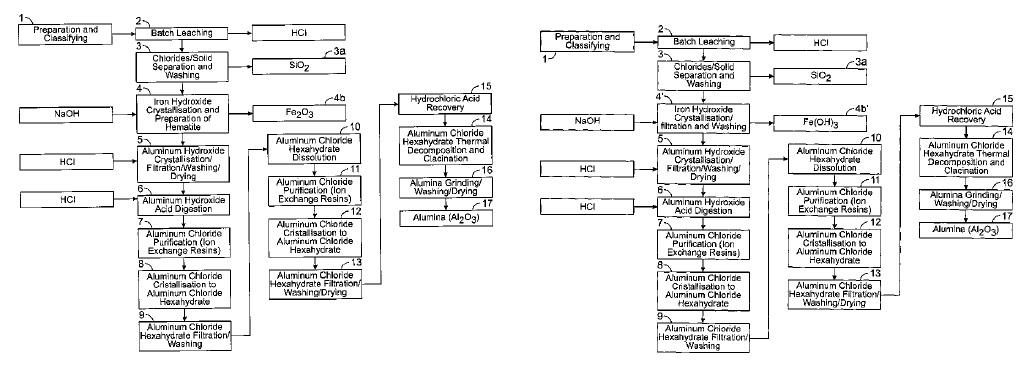
US9517498 — ALUMINUM IMPACT EXTRUDED BOTTLE WITH THREADED NECK MADE FROM RECYCLED ALUMINUM AND ENHANCED ALLOYS — Ball Corporation (USA) — The present invention relates generally to forming a threaded neck in a metal bottle manufactured by a process known as impact extrusion. More specifically, the present invention relates to methods, apparatus and alloy compositions used in the impact extrusion manufacturing of containers and other articles with sufficient strength characteristics to allow threading the container necks to receive a threaded closure on the threaded neck, wherein said the recycled aluminum alloy is comprised of a scrap metal of at least one of a 3104, a 3004, a 3003, a 3103, a 3013 and a 3105 aluminum alloy.
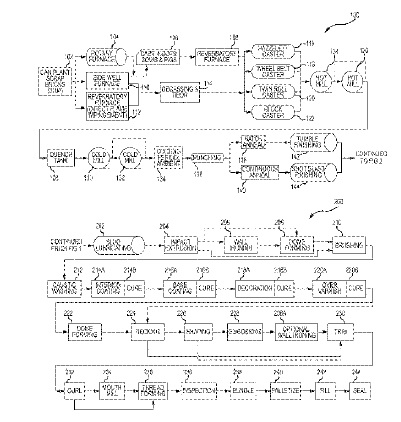
US9481918 — IMPACT RESISTANT SCRAP SUBMERGENCE DEVICE — Pyrotek, Inc. (USA) — A metal scrap submergence device having an open top chamber including side and base walls of a heat resistant material. An inlet is included in a side or base wall of the chamber for receiving molten metal. An outlet is included in the base of the chamber. A ramp extends from the side wall of the chamber to an inner column defining the outlet. The ramp includes a first edge adjacent the side wall and second interior edge adjacent the inner column. The working surface of the ramp between the first and second edges is concave. The inner column includes an end wall disposed opposite the chamber base, the end wall includes rounded inner and outer edges.

US9382595 — METHOD FOR THE PRODUCTION AND THE PURIFICATION OF MOLTEN CALCIUM ALUMINATE USING CONTAMINATED ALUMINUM DROSS RESIDUE — 9253-8444 QUEBEC INC. (Canada) — The present invention provides a process for the preparation of pre-melted calcium aluminate for iron and steel treatment and protection by the fusion of aluminum dross residues, usually referred to as non-metallic products (NMP) containing variable levels of aluminum (Al) and aluminum nitride (AlN) with calcium carbonate at high temperature, under oxidizing atmosphere. It further relates to the purification of the molten calcium aluminate from some contaminants present in the dross residue.

US9360253 — METAL KILN TEMPERATURE CONTROL SYSTEM AND METHOD — GILLESPIE + POWERS, INC. (USA) — A rotary aluminum kiln temperature regulation system comprising a temperature sensing device in the kiln that is configured to take temperature readings in an area of the kiln in proximity to the temperature sensing device. The system including a wireless transmitter operatively associated with the temperature sensing device and a receiver wirelessly associated with the transmitter, such that the transmitter and receiver wirelessly transmit the temperature readings taken by the temperature sensing device from the transmitter to the receiver. The system also including a control unit operatively connected to the receiver that is configured to receive the transmitted temperature readings and determine when the transmitted temperature readings exceed a predefined temperature set point. The control unit operatives one or more forward feed control loop subsystems that assist in safely operating the kiln in accord with a predetermined temperature profile programmed into the control unit.
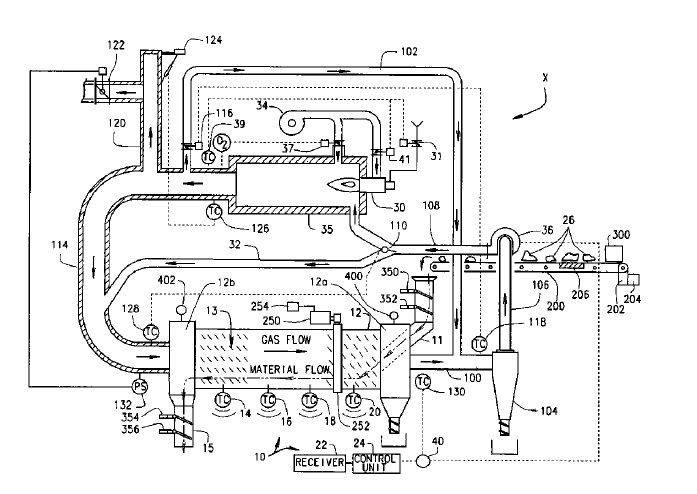
US9267214 — ALUMINUM RECOVERY PROCESS — Board of Trustees of the University of Alabama (USA) — Disclosed are processes and electrolytic cells that can be used to extract and thereby recover aluminum from aluminum-containing waste, including an aluminum dross that is suitable for disposal in a land-fill. The disclosed processes and cells use ionic liquids as an electrolyte.

US9222152 — ALUMINUM-MAGNESIUM ALLOY AND ALLOY PLATE THEREOF — Kobe Steel, Ltd. (Japan) — With increasing awareness of recycling from the perspective of energy conservation and low environmental load, some Al-Mg alloys are manufactured by using raw materials containing a given amount of P derived from aluminum scrap. Thus, there is a demand for a technique for suppressing molten metal oxidation even when such raw materials containing a given amount of P are used. An aluminum-magnesium alloy capable of suppressing molten metal oxidation even without adding Be, and an alloy plate of the aluminum magnesium alloy, are characterized by being obtained by adding 0.20 mass % or more of Cr and/or 0.002 mass % or more of Ca to an aluminum-magnesium alloy which contains 0.8-15 mass % Mg and, as an unavoidable impurity, 0.001 mass % or more of P.

US9091484 — METHOD AND APPARATUS FOR HEATING METALS — Air Products and Chemicals, Inc. (USA) — A method of heating a non-ferrous and/or ferrous metal-containing stock in a furnace with a heating chamber, a charging door, an exhaust stream port and an exhaust stream duct, which includes: a) introducing fuel and an oxygen-containing gas into the heating chamber of the furnace through a burner so that a flame is formed, b) monitoring the signal of at least one optical sensor installed within the heating chamber and/or the exhaust stream duct, c) monitoring the change of the temperature T of the exhaust stream with time (dT/dt), and d) adjusting the fuel/oxygen ratio in step a) as a function of the signal of the flame sensor(s) and dT/dt in the exhaust stream, and, an apparatus designed for implementing said method.

US8985472 — WIRELESS TEMPERATURE SENSING AND CONTROL SYSTEM FOR METAL KILN AND METHOD OF USING THE SAME — Gillespie + Powers, Inc. (USA) — A rotary aluminum kiln temperature regulation system comprising a temperature sensing device in the kiln that is configured to take temperature readings in an area of the kiln in proximity to the temperature sensing device. The system including a wireless transmitter operatively associated with the temperature sensing device and a receiver wirelessly associated with the transmitter, such that the transmitter and receiver wirelessly transmit the temperature readings taken by the temperature sensing device from the transmitter to the receiver. The system also including a control unit operatively connected to the receiver that is configured to receive the transmitted temperature readings and determine when the transmitted temperature readings exceed a predefined temperature setpoint. The control unit is operatively connected to a heat flow control device that can adjust heat flow inside the kiln in proximity to the temperature sensing device, such that the control unit regulates the heat flow control device to maintain a desired level of heat flow in the kiln in proximity to the temperature sensing device in response to the temperature readings transmitted from the temperature sensing device.

US8945464 — HEATING METHOD AND SYSTEM FOR CONTROLLING AIR INGRESS INTO ENCLOSED SPACES — Air Products and Chemicals, Inc. (USA) — This disclosure is generally directed to methods and systems for heating in an enclosed space. In particular, the disclosure is directed to a method and system for preheating ladles having an enclosed space for use with molten metal. An apparatus for heating vessels, the vessels having enclosed spaces therein and controlling air ingress into the enclosed spaces through gaps. The method includes providing a lid structure for the vessel having the enclosed space, the lid structure having a burner assembly mounted therein. The burner is configured to provide a predetermined flame diameter. The vessel and lid structure are mated such that the gap is formed between the vessel and the lid structure. Fuel and oxidant are discharged from the burner assembly under conditions to provide the predetermined flame diameter and impart a flame velocity sufficiently large to create an outward gas flow from the enclosed space through the gap and control air ingress.

US8917754 — ALUMINUM MELTING APPARATUS — Alcoa Inc. (USA) — A method and apparatus for melting aluminum uses a dense metal salt of Rubidium, Cesium, or Strontium. The salt is melted by a stinger and then superheated by AC applied to electrodes immersed in the salt. Aluminum in contact with the salt melts and floats on the salt. In continuous scrap melting, inflows and outflows of aluminum are comparable and may be shielded by inert gas. The superheated salt may be purified and may be heated in a separate reservoir and pumped to and from another reservoir containing salt and/or metal. The salt may be used to supplement the heating of an existing furnace.

US8845777 — METAL RECOVERY FROM CONTAMINATED METAL SCRAP — Chinook Sciences, Ltd. (England) — A metal reclaiming system and method for reclaiming metal from aluminum scrap material is provided. The system has a furnace (12) and a controller (106) for controlling operation of the system. The controller (106) operates the metal reclaiming system in a first operating mode in which the furnace (12) is operated at a first temperature in the range of 350°C. to 550°C to incinerate pollutants and drive off volatile organic compounds (VOCs) from the scrap material without melting the metal. The controller (106) is operates the metal reclaiming system in a subsequent operating mode in which the furnace (12) is operated at a further, higher temperature to melt metal in the said scrap for reclaiming.
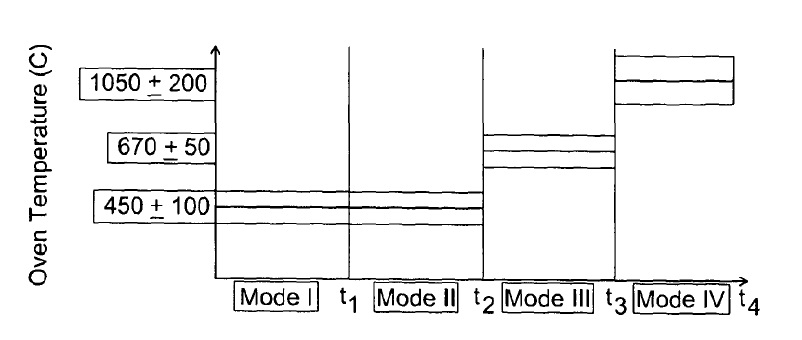
US8696348 — ULTRA-LOW NOx BURNER ASSEMBLY — Air Products and Chemicals, Inc. (USA) — Burner assembly comprising (a) an elongated body having a periphery, a discharge end adjacent a combustion zone, and an axis, wherein the axis extends into the combustion zone; (b) one or more oxidant nozzles disposed at the discharge end of the elongated body and adapted to discharge a gaseous oxidant into the combustion zone; and (c) one or more fuel nozzles disposed at the discharge end of the elongated body and adapted to discharge a fuel into the combustion zone. At least one of the oxidant and fuel nozzles is characterized by a shape factor, σ that is greater than about 10, wherein σ is a dimensionless parameter defined as σ=P2/2A where P is the perimeter dimension of the discharge opening and A is the area of the discharge opening.

US8632621 — METHOD FOR MELTING A SOLID CHARGE — L’Air Liquide, Societe Anonyme pour l’Etude et l’Exploitation des Procedes Georges Claude (France) — The present invention relates to the melting of a solid charge such as glass or metal, and in particular, to the recycling of metal through scrap metal melting and refining. A simple, compact burner achieves a more optimal melting of a solid charge followed by performance of combustion under distributed combustion conditions. The burner achieves this by fluidically bending the flame towards the solid charge during a melting phase with an actuating jet of oxidant, redirecting the flame in a direction away from the charge, and staging injection of oxidant among primary and secondary portions during a distributed combustion phase.

US8599899 — AGITATION DEVICE, MELTING APPARATUS AND MELTING METHOD — Toyota Jidosha Kabushiki Kaisha (Japan) — An agitation device, a melting apparatus, and a melting method for improving melting efficiency of molten metal without contaminating the same. The agitation device is provided with a traveling magnetic field generating unit which is disposed outside a charging tank for storing molten metal and generates, inside the charging tank, a magnetic field that travels downward along the rear sidewall of the charging tank. A flow of the molten metal that rotates longitudinally about an axis approximately parallel to the surface of the molten metal is produced in the molten metal. By charging aluminum cutting chips into the molten metal in which the flow is produced, the aluminum cutting chips move with a downward flow of the molten metal and are immersed in the molten metal. As a result, melting of the aluminum cutting chips can be accelerated.

US8578869 — BOTTLE FURNACE — Chinook Sciences LLC (USA) — A method and apparatus to batch de-coat the organics in metal scrap, and/or gasify the organics from certain types of waste material (including biomass, municipal solid waste, industrial waste, and sludge). The apparatus is suited for use on a batch tilting single entry rotary furnace of the type used to melt the metal scrap in the aluminum industry. The apparatus uses a burner in the tilting rotary furnace but does not necessarily melt the metal scrap. It preferably operates below the melting temperature of the metal scrap (<1400°F) and below the stoichiometric level (more specifically <12% oxygen) to partially combust the organic in the tilting rotary furnace. The gasified organics depart the furnace in a complete closed circuit where no air is allowed to entrain into the flue gases. These organic filled gases (synthetic gases) are fully incinerated in a separate thermal oxidizer where a stoichiometric burner uses either natural gas or liquid fuel to ignite the synthetic gas. The system can identify when the organics are fully gasified, and the metal scrap is fully clean.

US8414825 — MOVABLE SWEAT HEARTH FOR METAL MELTING FURNACE — Novelis Inc. (Canada) — Exemplary embodiments provide a movable sweat hearth for use with a metal melting furnace having a wall provided with a metal-loading entrance. The sweat hearth includes a hearth body movable relative to the furnace into and out of contact with the wall of the furnace at the entrance. The body has exterior walls enclosing a hollow interior except at a furnace-engagable side wall of the hearth body provided with an opening communicating with the interior. The interior has a floor adapted to support a charge of scrap metal, and the opening is positioned relative to the floor to allow molten metal to drain from the interior through the opening. The floor is arranged at an angle to horizontal to slope in a downward direction towards the opening when the container is moved into sealing engagement with the wall of the furnace with the opening aligned with the furnace entrance. Other exemplary embodiments relate to a combination of a movable sweat hearth as described above and a metal melting furnace having a front wall provided with a furnace entrance.

US8313554 — METHOD FOR THE SEPARATION OF MOLTEN ALUMINUM AND SOLID INCLUSIONS — Aleris Switzerland GmbH (Switzerland) — A method for the separation of a dispersion of molten aluminium and solid inclusions formed from a melt of aluminum containing one or more foreign chemical elements. Molten aluminum surrounding the solid inclusions is at least essentially replaced by a molten salt.
US8002872 — METHODS OF RECOVERING AND PURIFYING SECONDARY ALUMINUM — Carbontech, LLC (USA) — The invention provides efficient and effective processes for recovering metals such as aluminum, magnesium and lithium from mixed waste sources such as auto shredder residue, aluminum cans, waste particles of aluminum alloy and municipal waste. The metal-waste source is dissolved in a more noble metal solvent at a temperature at which contaminants do not dissolve. The purified metal is then recovered from the solvent, preferably by electrorefining.
US7582252 — PLANT WITH ROTATING FURNACE FOR THE MELTING WITHOUT SALT OF ALUMINUM WITH SCREENING AND RECOVERY OF THE SLAGS — Hitech S.R.L. (Italy) — A plant is provided for the melting of primary and secondary aluminum, provided with a rotating furnace, internally equipped with a spiral element (11), that causes the melting of the aluminum not requiring use of a salty bath. The plant includes a pouring channel (13) adjacent an exit hole (4) of the rotating furnace and material from the pouring channel enters the spherical store basin (16) positioned below if, the spherical store being equipped with a rotating joint (17) having a common inclination with the pouring channel (13) so that what is obtained is the direct and continuous flow of the fused metal in the spherical store without interruption of the process of melting. The plant is also equipped with an automatic and continuous system of selection and recovery of the slag of fusion, integrated in the same plant, and a double system of canalization of the gases that allows cleaning of the pollutant agents and energy conservation in the melting furnace.

US7550028 — METHOD FOR RECYCLING ALUMINUM-LITHIUM-TYPE ALLOY SCRAP — Alcan Rhenalu (France) — The present invention is directed to a method for melting scrap of an aluminum alloy containing lithium. The steps include providing scrap containing aluminum-lithium-type alloys, preparing an initial liquid metal bed of a first composition in a smelting oven, loading the scrap onto the initial liquid metal bed so as to create a floating layer of the scrap with a controlled thickness at the surface of the liquid metal bed, partially melting the floating layer via contact with the metal bed so as to obtain a liquid metal bath having a second composition, and removing the liquid metal from the second composition of the liquid metal bath. The method has technical and economic advantages. It does not require investment in a particular installation and it requires minimal use of expensive expendable materials such as inert gas, because the formation of a floating layer having a controlled thickness makes it possible to effectively protect the surface of the liquid metal from oxidation.

